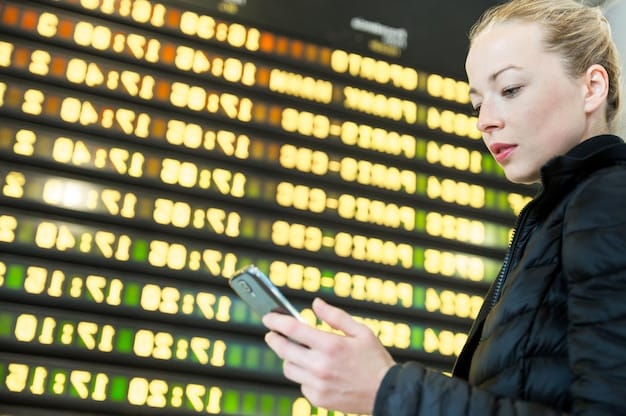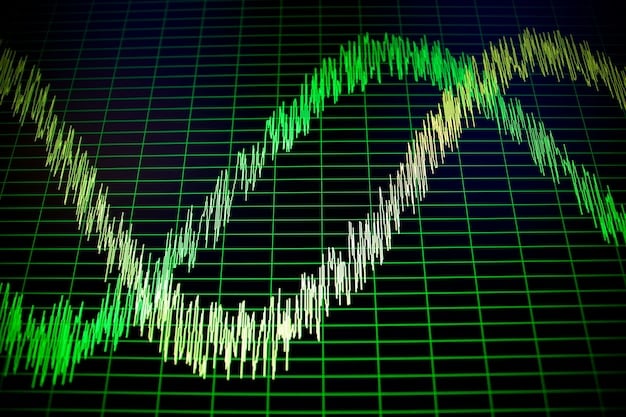Japan Currency Exchange: Maximize Your Dollars in 2025

Japan’s Currency Exchange Guide: Maximizing Your US Dollars in 2025 provides essential strategies for American travelers to optimize their currency exchange, including timing, locations, card usage, and budgeting tips to enhance their travel experience.
Planning a trip to Japan in 2025? Navigating currency exchange can significantly impact your travel budget. This Japan’s Currency Exchange Guide: Maximizing Your US Dollars in 2025 offers practical tips to ensure you get the most yen for your dollar, enhancing your overall travel experience.
Understanding the Yen: A Quick Overview for Americans
Before diving into the specifics of currency exchange, it’s important to understand the basics of the Japanese Yen (JPY). The Yen is the official currency of Japan, and it comes in various denominations of banknotes and coins. Familiarizing yourself with these denominations will help you manage your cash effectively while in Japan.
Yen Denominations: Banknotes and Coins
Japanese banknotes come in denominations of 1,000 yen, 2,000 yen, 5,000 yen, and 10,000 yen. Coins are available in 1 yen, 5 yen, 10 yen, 50 yen, 100 yen, and 500 yen. It’s a good idea to have a mix of both banknotes and coins for various transactions, as some smaller establishments may not accept credit cards or larger bills.
Historical Exchange Rates: USD to JPY
The exchange rate between the US dollar (USD) and the Japanese Yen (JPY) can fluctuate based on various economic factors. Historically, the rate has varied significantly. Keeping an eye on the current exchange rate trends in the months leading up to your trip can help you make informed decisions about when to exchange your money.
- Check Historical Data: Use financial websites to review past USD to JPY exchange rates.
- Follow Economic News: Stay updated on economic events that may impact currency values.
- Set Rate Alerts: Use apps or services that notify you when the exchange rate reaches a favorable level.
Understanding these basics will set you up for a smoother currency exchange experience in Japan. By knowing the yen denominations and monitoring exchange rate trends, you can better plan your finances and take advantage of favorable exchange rates.

In summary, being aware of the yen and its historical exchange rates is crucial for any American traveler heading to Japan. This knowledge will help you make informed decisions and potentially save money during your trip.
Best Places to Exchange USD to JPY in the US
Exchanging your currency before you leave the US can provide peace of mind and ensure you have some yen in hand upon arrival. However, it’s important to choose the right place to exchange your USD to JPY to get the best possible rates and avoid excessive fees.
Banks and Credit Unions
Your local bank or credit union is a reliable place to exchange currency. They often offer competitive exchange rates and lower fees compared to other options. It’s advisable to check with your bank in advance to see if they have JPY in stock and what their current exchange rate is.
Currency Exchange Services
Currency exchange services like Travelex or Currency Exchange International (CXI) are other options to consider. These services have physical locations in many cities and offer online platforms for currency exchange. Compare their rates and fees with those of your bank to ensure you’re getting a good deal.
Online Currency Exchange Platforms
Several online platforms allow you to exchange currency and have it delivered to your home. These platforms can offer competitive rates, but it’s essential to research their reputation and ensure they are a legitimate and secure service.
- Compare Rates: Always compare exchange rates across different platforms.
- Check Fees: Be aware of any transaction fees or commissions.
- Read Reviews: Look for customer reviews to ensure the platform is reliable.
Choosing the right place to exchange your USD to JPY in the US can significantly impact how much you get for your money. By considering banks, currency exchange services, and online platforms, you can find the best option that suits your needs and ensures a favorable exchange rate.
In conclusion, exchanging currency in the US requires careful consideration of different options. Comparing rates, checking fees, and reading reviews will help you make an informed decision and maximize your US dollars before you even set foot in Japan.
Exchanging Currency Upon Arrival in Japan
Once you arrive in Japan, you’ll have several options for exchanging USD to JPY. Understanding these options and their pros and cons can help you make the best choice based on your needs and location.
Airport Currency Exchange Counters
Airports in Japan, such as Narita (NRT) and Haneda (HND), have currency exchange counters that are convenient for travelers. However, these counters often have less favorable exchange rates and higher fees compared to other options. They are a good choice if you need immediate access to yen, but try to exchange only a small amount.
Banks and Post Offices
Japanese banks and post offices are reliable places to exchange currency. Banks like MUFG, SMBC, and Mizuho offer currency exchange services, and Japan Post Bank is also an option. These institutions typically offer better exchange rates than airport counters. Remember to bring your passport for identification.
Utilizing ATMs in Japan
ATMs are a convenient way to withdraw yen using your US debit or credit card. Look for ATMs that accept international cards, such as those at 7-Eleven convenience stores (Seven Bank ATMs) or Japan Post Bank. Be aware of potential transaction fees charged by your bank and the ATM operator.
- Check for International Acceptance: Ensure the ATM displays symbols of major card networks like Visa or Mastercard.
- Know Your Bank’s Fees: Understand the international transaction fees charged by your bank.
- Withdraw Larger Amounts: To minimize fees, consider withdrawing larger amounts less frequently.
Choosing the best place to exchange currency upon arrival in Japan depends on your priorities. While airport counters offer immediate convenience, banks and ATMs generally provide better exchange rates and lower fees. By carefully considering your options, you can make the most of your US dollars.
In summary, exchanging currency in Japan requires weighing convenience against cost. While airport counters are easily accessible, banks and ATMs usually offer more favorable terms. Planning ahead and knowing your options will help you optimize your currency exchange strategy.
Navigating Exchange Rates and Fees
Understanding how exchange rates and fees work is crucial for maximizing your US dollars when converting them to Japanese Yen. By being aware of these factors, you can make informed decisions and avoid unnecessary costs.
Understanding Exchange Rate Fluctuations
Exchange rates between the US dollar and the Japanese Yen can fluctuate daily due to various economic and geopolitical factors. These fluctuations can impact how much yen you receive for your dollars. It’s wise to monitor exchange rate trends in the weeks or months leading up to your trip.
Hidden Fees and Commissions
Many currency exchange services charge hidden fees or commissions that can eat into your exchange rate. Always ask about any fees upfront and compare the total cost across different providers.
Tips to Secure Better Exchange Rates
Securing a better exchange rate involves a combination of timing, location, and negotiation.
- Monitor Exchange Rates: Use online tools to track USD to JPY exchange rates.
- Avoid Airport Exchanges: Airport currency exchange counters often have the worst rates.
- Negotiate Rates: If exchanging a large amount, try to negotiate a better rate.
Navigating exchange rates and fees effectively can result in significant savings when exchanging USD to JPY. By understanding how these factors work and implementing smart strategies, you can maximize the value of your US dollars.

In conclusion, a strong understanding of exchange rates and fees is essential for any traveler converting USD to JPY. By staying informed and proactive, you can make the most of your money and enjoy a more budget-friendly trip to Japan.
Leveraging Credit and Debit Cards Wisely
Using credit and debit cards in Japan can be a convenient way to pay for goods and services, but it’s important to understand the associated fees and potential pitfalls. Wise card usage can help you manage your finances effectively while traveling.
Credit Card Usage in Japan
While credit cards are becoming more widely accepted in Japan, especially in larger cities and tourist areas, it’s still common to encounter establishments that only accept cash. Visa and Mastercard are generally accepted, but Discover and American Express may have limited acceptance. Be sure to inform your bank of your travel plans to avoid any issues with your card being blocked.
Debit Card Usage in Japan
Debit cards can be useful for withdrawing cash from ATMs, but they typically incur international transaction fees. Look for ATMs that accept international cards, such as those at 7-Eleven stores (Seven Bank ATMs) or Japan Post Bank.
Avoiding Foreign Transaction Fees
Foreign transaction fees can add up quickly, so it’s wise to minimize them.
- Use Fee-Free Cards: Consider using credit or debit cards that don’t charge foreign transaction fees.
- Pay in Local Currency: Always choose to pay in Japanese Yen to avoid unfavorable exchange rates imposed by the merchant.
- Limit ATM Withdrawals: Withdraw larger amounts less frequently to reduce ATM fees.
Using credit and debit cards wisely in Japan involves understanding acceptance rates, potential fees, and smart strategies to minimize costs. By being informed and proactive, you can leverage your cards effectively and manage your travel expenses more efficiently.
In summary, using credit and debit cards in Japan requires careful planning and awareness of potential fees. By choosing the right cards, paying in local currency, and limiting ATM withdrawals, you can make the most of your US dollars and enjoy a smoother travel experience.
Budgeting and Planning for Currency Exchange
Effective budgeting and planning are essential for maximizing your US dollars when traveling to Japan. By carefully planning your expenses and exchange strategy, you can ensure you get the most value for your money.
Estimating Your Daily Expenses
Before your trip, estimate your daily expenses, including accommodation, food, transportation, and activities. This will help you determine how much yen you need to exchange. Research the average costs of these items in Japan to create a realistic budget.
Creating a Currency Exchange Timeline
Create a timeline for exchanging your currency to take advantage of favorable exchange rates. Monitor exchange rates in the weeks leading up to your trip and consider exchanging a portion of your money in advance and the rest upon arrival.
Contingency Planning for Currency Needs
It’s wise to have a contingency plan for unexpected expenses or currency needs. This could include having a credit card with no foreign transaction fees or setting up a travel alert with your bank. Having a backup plan will provide peace of mind and ensure you’re prepared for any situation.
- Set a Budget: Determine how much you can spend each day.
- Monitor Exchange Rates: Track USD to JPY exchange rates regularly.
- Have a Backup Plan: Ensure you have access to additional funds if needed.
Budgeting and planning for currency exchange are key to maximizing your US dollars when traveling to Japan. By estimating your expenses, creating a timeline, and having a contingency plan, you can ensure a smooth and financially savvy trip.
In conclusion, careful budgeting and planning are essential components of a successful currency exchange strategy for travel to Japan. By taking the time to estimate your expenses and monitor exchange rates, you can make informed decisions and get the most out of your US dollars.
Additional Tips for a Smooth Currency Experience
To ensure a smooth currency exchange experience in Japan, consider these additional tips. These insights can help you navigate the process more efficiently and avoid common pitfalls.
Learn Basic Japanese Phrases
Knowing basic Japanese phrases can be helpful when exchanging currency at banks or post offices. Phrases like “I would like to exchange currency” (Ryogae o onegai shimasu) can make the process smoother.
Keep Small Denominations Handy
Having small denominations of yen is useful, especially when visiting smaller establishments or using vending machines. Break down larger bills at convenience stores or train stations.
Stay Informed on Local Customs
Be aware of local customs related to handling money. In Japan, it’s customary to place money in a tray when making a purchase rather than handing it directly to the cashier. This shows respect and ensures a smooth transaction.
- Learn Basic Phrases: Knowing simple Japanese can be very helpful.
- Keep Small Bills: Have a mix of small and large denominations.
- Respect Local Customs: Be aware of Japanese etiquette when handling money.
These additional tips can enhance your currency exchange experience in Japan. By learning basic phrases, keeping small denominations handy, and staying informed on local customs, you can navigate the process more confidently and respectfully.
In summary, these additional tips are designed to make your currency exchange experience in Japan as smooth and seamless as possible. By preparing in advance and being mindful of local customs, you can ensure a positive and stress-free experience.
| Key Point | Brief Description |
|---|---|
| 💰 Exchange Locations | Compare rates at banks, airports, and ATMs for the best deal. |
| 📈 Monitor Rates | Track USD to JPY rates to find favorable exchange opportunities. |
| 💳 Card Usage | Use credit cards with no foreign transaction fees wisely. |
| 💴 Small Bills | Keep small denominations for smaller establishments. |
FAQ
▼
Banks and post offices generally offer better exchange rates than airport currency exchange counters. ATMs are also a convenient option for withdrawing yen.
▼
Use credit or debit cards that don’t charge foreign transaction fees. Always choose to pay in Japanese Yen to avoid unfavorable exchange rates.
▼
Exchanging a small amount of currency before your trip can be helpful, but it’s often better to wait until you arrive in Japan to get better rates.
▼
Withdraw cash from an ATM at a 7-Eleven or Japan Post Bank. These ATMs typically accept international cards. Always be aware of potential fees.
▼
Use online tools and financial websites to track USD to JPY exchange rates. Many apps also offer rate alerts to notify you of favorable rates.
Conclusion
Maximizing your US dollars in Japan requires careful planning and a strategic approach to currency exchange. By understanding exchange rates, fees, and the best locations for exchanging money, you can ensure a budget-friendly and enjoyable trip to Japan in 2025.





